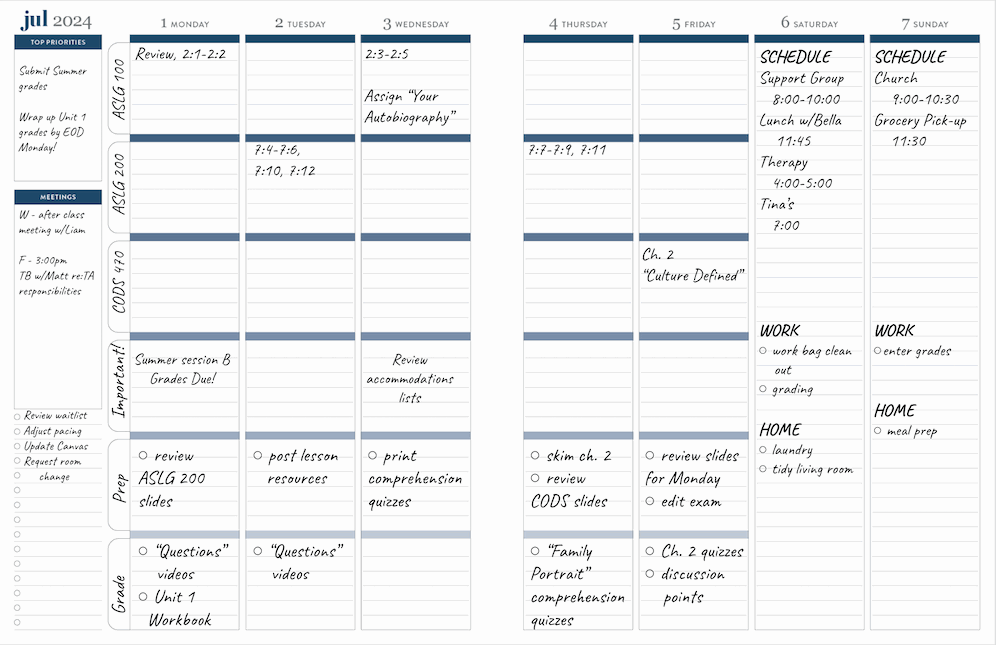How to Use a Teacher Planner for Professors: A Comprehensive Guide

Feeling overwhelmed by your university workload? Discover how a Teacher Lesson Planner can transform your semester. Master course schedules, manage student workload, and gain control with organization hacks for professors. In this comprehensive guide, we will explore how university professors can effectively use a paper teacher planner to complement college digital tools to enhance course organization and productivity.
How to Use a Paper Teacher Planner for College?
Adapting a paper teacher planner for university courses is quite effective with their versatile and tactile structure. Professors can easily transform the weekly and daily spreads of a paper teacher planner to organize lectures, seminars, and office hours, tailoring the planner to fit diverse teaching styles. The best teacher planners for professors have checklist and notes sections perfect for creative uses beyond college lesson plans, such as to-do lists, grading schedules, student meeting notes, research references, and departmental reminders.
The monthly calendars in a paper teacher planner are valuable tools for managing college departmental meetings, conferences, deadlines, and guest speaker schedules, helping professors master their schedules with ease and efficiency. With the flexibility and comprehensive layout, paper teacher planners are essential tools for effective college lesson planning and academic management.
How Does a Paper Teacher Planner Supplement Digital Planning Tools?
Many university professors rely on digital planning tools for their convenience and accessibility. However, a paper teacher planner can supplement these tools by offering a tangible and customizable experience. Integrating a paper planner with digital calendars allows for a seamlessly connected system, providing a comprehensive view of your schedule and tasks.
Professors can use a paper planner to jot down quick notes, brainstorm ideas, and plan in more detail than digital tools might allow. This hybrid approach ensures that no detail is overlooked and that your planning process is both thorough and adaptable.
How Do You Use a Teacher Planner Effectively?

Why Educators Prefer the Erin Condren Teacher Lesson Planner Over Others
Educators prefer the Erin Condren Teacher Lesson Planner because of its high-quality design, customizable layouts, and comprehensive features. This planner is specifically designed to meet the needs of teachers, including university professors, making it an ideal choice for those looking to improve their course organization and productivity.
The Erin Condren planner offers various sections for lesson plans, notes, checklists, and monthly calendars, allowing professors to keep all their planning materials in one place. Its flexibility and attention to detail make it a standout option for college lesson planning. As a university professor planner, it is tailored to meet the specific demands of higher education, providing a robust framework for academic success.
How Do You Adapt the Erin Condren Teacher Lesson Planner for College?
How to Use Weekly Planning Pages

Customizing the weekly spreads for lectures, seminars, office hours, and other activities is essential for effective use. Some Erin Condren Teacher Lesson Planners have two layout options for the weekly planning pages: vertical (Monday - Sunday) or horizontal (Monday - Friday). This flexibility accommodates diverse teaching styles and schedules.
Professors can use the vertical layout to plan out each day in detail or the horizontal layout for a broader overview. This adaptability ensures that the planner can be tailored to suit the specific needs of university course organization. Effective use of the weekly planning pages can significantly enhance professor schedule management.
How to Use the Monthly Calendars

The monthly calendars are perfect for managing deadlines, meetings, conferences, training sessions, and overall professor schedules. By plotting out important dates and events in the monthly view, professors can ensure they stay on top of their commitments and maintain a well-organized schedule.
Using color-coding for different types of events or tasks can further enhance the organization and clarity of your monthly calendar, making it easier to manage a busy academic schedule. This is one of the many teacher planner productivity tips that can streamline your planning process.
How to Use the Productivity Pages, Checklists, and Other Features

Beyond lesson plans, the Erin Condren teacher planner offers various features to help professors stay organized. The checklist pages can be used for tracking to-do lists, grading schedules, and student meeting notes. The communication logs are perfect for keeping records of student interactions and follow-ups.
The note pages provide space for brainstorming, jotting down research references, and departmental reminders. The goal-setting sections and monthly productivity pages can help professors set and track academic and personal goals. Additionally, the planner's stickers and decorative elements can add a personal touch to your planning process. These professor organization hacks ensure that all aspects of academic responsibilities are managed efficiently.
How Do You Create College Lesson Plans?

Creating college lesson plans involves outlining the key components of each lecture or seminar. The five basic parts of a lesson plan include objectives, materials needed, introduction, main activities, and assessment methods. These elements ensure that each class is structured and achieves its educational goals.
What Are the 5 Basic Parts of a Lesson Plan?
Creating college lesson plans involves outlining the key components of each lecture or seminar. The five basic parts of a lesson plan include:
- Objectives
- Materials needed
- Introduction
- Main activities
- Assessment methods
These elements ensure that each college class is structured and achieves its educational goals.
What Are the 5 Steps in a Lesson Plan?
Taking a structured approach to lesson planning ensures that all necessary components are covered and that each college lesson is well-organized and effective. The five steps in a lesson plan are:
- Identifying the objectives
- Planning the introduction
- Developing the main activities
- Preparing the assessment
- Reflecting on the lesson's effectiveness
Reflecting on the lesson’s effectiveness allows professors to make adjustments for future lessons, ensuring continuous improvement in their teaching methods. Here are additional resources, including lesson planning templates.
How Do You Fill Out an Erin Condren Teacher Lesson Planner for University Lesson Plans?

Using an Erin Condren Teacher Lesson Planner can help professors structure these steps and create comprehensive lesson plans for their university courses. Professors should start by listing the objectives and materials needed for each class. Next, they can outline the introduction, main activities, and assessment methods.
This structured approach ensures that all necessary components are covered and that each lesson is well-organized and effective. The flexibility of the Erin Condren planner allows for detailed planning and easy adjustments as needed, making it an excellent tool for customizing unique college lesson plans.
What Should a College Lesson Plan Look Like?
A college lesson plan should be detailed yet flexible, allowing for adjustments as needed. Including space for notes and reflections can help professors continuously improve their lesson plans and teaching methods.
The plan should clearly outline the objectives, materials, introduction, main activities, and assessment methods, providing a comprehensive guide for each class. This ensures that professors are well-prepared and that university students receive a structured and effective learning experience.
Lesson Planning Tips for College Professors

Analog and Digital Harmony
Integrating a paper teacher lesson planner with digital calendars or note-taking apps can create a seamlessly connected system. This approach allows professors to benefit from the tactile experience of a paper planner (including improved memory, better stress management, among other benefits of writing vs. typing) while leveraging the convenience of digital tools. Digital planning tools can include university planning and communication apps, reminders, notifications, and the ability to share schedules with colleagues or students.
Combining both analog and digital planning ensures that no detail is overlooked and that professors can access their plans and schedules from anywhere. This hybrid approach maximizes efficiency and organization. Digital and analog planning for professors provides the best of both worlds, enhancing overall productivity.
Systematize Your Success
Creating a system for recording lecture notes, readings, and assignments within the planner can make referencing easier. By organizing these materials systematically, professors can quickly find and use them in future classes. This approach ensures that all relevant information is easily accessible and well-organized.
Using tabs or dividers to separate different sections of the planner can further enhance organization and efficiency. This method allows professors to keep track of various aspects of their teaching responsibilities in a streamlined manner. Using planning accessories like dashboards, organizers, and more within your planner can make this process even more efficient.
Embrace the Blank Box
You don't need to fill every box in your planner. Having blank squares allows you to visualize your schedule without feeling overwhelmed. It's not a waste to leave Monday, Wednesday, and Friday blank if your class only meets on Tuesday and Thursday.
This approach helps you focus on the days that require your attention and prevents your planner from becoming cluttered. Embracing blank spaces can lead to a more organized and manageable schedule. This is one of the key teacher planner productivity tips that can help maintain clarity and focus.
Live Beyond Labels
Experiment with the subject labels in your planner. Just because they are intended for subjects doesn't mean that's what you have to use them for. Does it work best for you to use them to list out each class period to have a clear visual schedule or list unique preps to each subject in a single row?
Feel free to customize these labels to suit your needs, including using customizable stickers so you don't have to write in each subject, each week. Whether you use them for class periods, office hours, or personal tasks, make sure the labels work for you and enhance your planning process. Professor organization hacks like these ensure that your planner is tailored to your specific needs.
Conquer Complexity with Color

Color-coding for courses, topics, or assessment types can visually organize a busy schedule. Using different colors for different types of tasks can make your planner more intuitive and easier to navigate. This method helps you quickly identify specific tasks and stay organized.
Keeping track of a course with multiple sections all in one row? Color-code it! Like the idea of writing pacing notes on the day your class meets but can't stand blank boxes? Fill them in with washi tape or decorative stickers!
Color-coding for teacher planners is a simple yet effective way to enhance visual organization and ensure that you stay on top of your schedule. This technique is one of the best ways to organize a university course load efficiently.
Utilizing a paper teacher planner can significantly enhance your organization and productivity as a university professor. By customizing the Erin Condren Teacher Lesson Planner to suit your specific needs, you can manage your course schedules, student workload, and academic responsibilities with ease. Integrating both analog and digital planning tools ensures a comprehensive and connected planning system.
Experiment with different layouts, labels, and color-coding methods to find what works best for you. Embrace the flexibility and versatility of the Erin Condren Teacher Lesson Planner to create a planning system that supports your teaching style and academic goals. Whether you are looking for tips for staying on top of deadlines as a university professor or the best way to organize a university course load, this planner can be your ultimate tool. Explore all types of planners to customize the right one for your style, schedule, and planning needs.

Related Lesson Planning Guides
You may also enjoy these other popular, guided planning tips, prompts, and inspiration from our lesson planning experts: